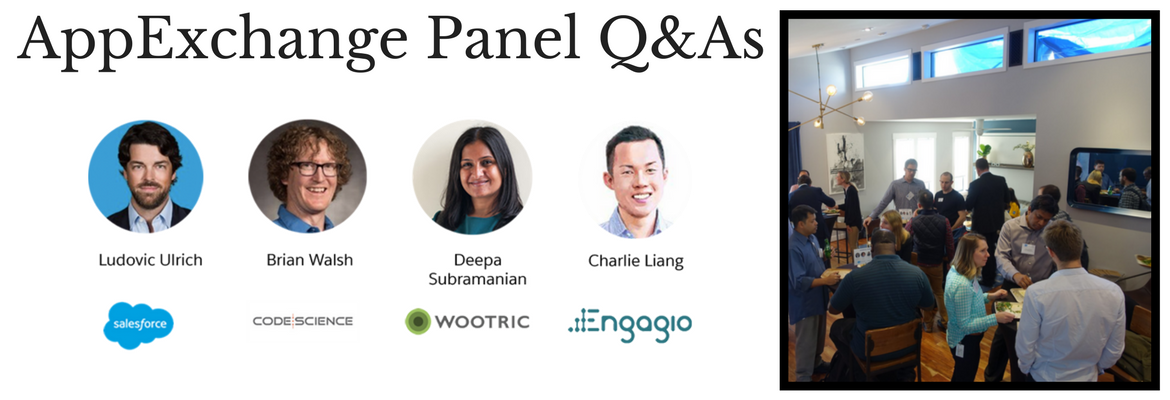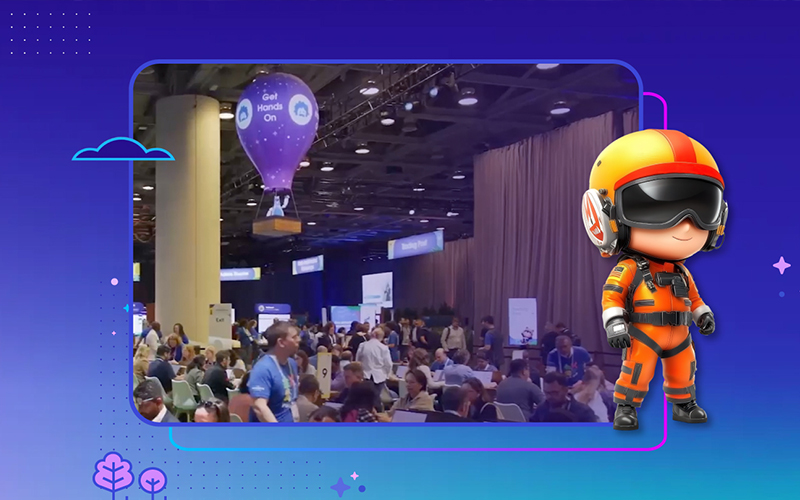
SaaStr Annual 2018 was jam-packed in both schedule and participants this year, but those who made time for Salesforce’s lunch and learn heard from experts who answered some top-of-mind questions about getting started — and being successful — on the Salesforce AppExchange. Panelists included:
- Ludovic Ulrich, Senior Director, Salesforce for Startups
- Deepa Subramanian, CEO, Wootric
- Charlie Liang, Director of Marketing, Engagio
- Brian Walsh, CEO, CodeScience
Here’s a breakdown of the burning questions covered by these masters, who shared lessons and advice on what you can expect.
Why Should We be on the AppExchange?
Simply, joining the AppExchange allows businesses to grow their customer bases.
Subramanian said that Wootric joined the AppExchange because they had been successful with small to medium sized businesses, but wanted a way to engage with upmarket customers who may be less technical. Salesforce provided that channel for them and enabled the company to build its product using best practices and input from customers. In the year that followed their first product launch, Wootric obtained 250 upmarket customer leads, leading to 50 customers that utilize them for the AppExchange.
Joining the AppExchange also contributes to more customers trusting your product. Engagio previously only used a Chrome extension to provide a user experience inside of Salesforce. As Engagio grew, Liang states that they were “increasingly running into customers that would not work with us unless we were listed on the Salesforce AppExchange.”
Only two months after they formalized their relationship with Salesforce and launched their app, they saw almost 50 organic leads from the AppExchange. Initially, they thought it would be just Salesforce operations professionals using their product, but they saw a lot of executives and marketing leaders – indicating a greater-than-anticipated product market fit.
What are the Components of an AppExchange Build?
The AppExchange has numerous commercial agreements available that allow you to solve the problems that consumers are facing — ISVforce, Connector apps vs fully native, OEM reselling, etc — that help partners to engage with Salesforce and drive revenue through its channels.
Walsh stressed that developing using Lightning Components (don’t panic — brush up here) empowers your Salesforce Administrators to easily build solutions on top of your product. Pro tip from Walsh on getting bang from your buck by nurturing this key relationship:
“The Salesforce administrator is the person who actually rolls your product out — so considering them and their needs allows your product to really become sticky.”
Great conversation on the importance of the @salesforce admin. @appexchange & @codescience lunch & learn #sasstr #SasstrAnnual pic.twitter.com/zGbegaoJvI
— Erin Murray (@ErinMurray415) February 7, 2018
How Does the Launch Process Work?
Salesforce has recently streamlined the launch process, making it much easier for new partners to release a finished product.
The first step is to go to partners.salesforce.com to sign up for free. From there, a process will start walking you through how to launch. There are two big milestones within the launch process. The first is getting your deal package put together; this is your commercial agreement stating that you are assigned with Salesforce as a partner.
The second and most important milestone is Security Review. This involves testing your products and apps in order to ensure that customers can trust you. This is a huge pain point in the launch process for many a first-timer. Walsh states that he loves Security Review (most would call this a hot take, but hear him out) because “the likelihood that a Fortune 100 company is just going to install it off the AppExchange and try it, is real.”
A lot of effort goes into this essential safeguard. Here’s our guide to making it through. Also check out our 9 Secrets to Building a Successful AppExchange App – what you need to know before you start.
What did your Launch Process Look Like?
Subramanian said she strategized for Wootric’s launch by having conversations with other companies about what they had done to be successful, which helped her prepare. She also emphasized to “make sure that your Salesforce administrator has a really easy path to getting what his business users need from him or her” which will allow a smoother launch.
Liang said that setting up his AppExchange listing did not take Engagio as long as expected. It took him 2 to 3 hours to get the listing up on the marketing side and was relatively easy.
Walsh took it back to the theory of SaaS: you identify a problem in the world, you identify who has that problem, create a hypothesis on how to fix that problem, and test if the hypothesis works. He states that this cycle is the only job of a SaaS company for about the first year and a half, so the faster you are able to go through the cycle, the better you can find product-market fit and start selling. It is important to talk to the people that have the problem you identified as part of market research in order to formulate and test your hypothesis as quickly as possible. What’s neat is that you can mock up your hypothesis build in Salesforce without actually building the product — which will save you time and money.
What Advice Do You Have for Those Preparing for Their First Launch?
Consider this a suite of pro tips from panelists.
Engagio
Track your results. Liang emphasized the importance of tracking when setting up your AppExchange listing so that you can understand where leads come from. This can be done by setting up all of the links with UTM codes and defining a process for tagging AppExchange leads. Tracking provides context into value you are deriving from the AppExchange, and what you can do to increase it.
Wootric
Customer success is key. Subramanian detailed the importance of having the right customer success person — and program — in place, which helps you build relationships with Salesforce roles as well as to keep your existing and potential customers happy. You’ll have to stream the recording for her specific example, which involved a conference that got a bit out of hand.
CodeScience
Salesforce won’t do it all for you. “They are not going to sell your product, tell you what to build, or tell you how to price it,” Walsh said. The Salesforce team has 3000 SKUs of products, meaning they are not able to socialize your product to every salesperson or internal product manager — that’s on you.
It comes down to hard work. According to our State of AppExchange Partners Report, 4% of the Salesforce partners we interviewed expect to have a liquidity event this year — and they got there by working extremely hard. While there are great tools, checklists, and partner communities available, Walsh wrapped up by saying “it’s really your job because it’s your company, your idea, and your outcome. You have to own that.”
Looking to accelerate your go to market on the AppExchange? We’ve launched 250+ products and can help, whether you’re at idea stage or about to take the Security Review plunge. Let’s talk!


